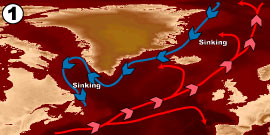|
II
RELATIONSHIP BETWEEN OCEAN AND ATMOSPHERE
|
1st
PART
THE
OCEANIC CIRCULATION
The
ocean covers 71% of the surface of the Earth (about 361 millions
km2) representing 1,322 billion km3
of water !
Ocean
dynamics is mainly driven by atmospheric circulation and the
rotation of the Earth. Pressure and wind especially explain
to a considerable extent the existence and current direction
of the surface. The movements of these latters are also related
to the density of water, which varies depending on temperature
and salinity.
The
Ekman theory helps explain why currents describe cell movements.
Phenomena of divergences and convergences are caused by the
effect of wind and the Coriolis
deflection.
- When we have a wind of anticyclonic origin (in the sense
of turning clockwise in the northern hemisphere), the water
accumulates (convergence) in the center. Then to compensate
for the elevation of the surface, thermocline immerses in
the depth.
- When we have winds depressions (rotating in the opposite
direction clockwise in the northern hemisphere) the phenomenon
is reversed, causing a rising of sea water and a rise in the
thermocline movement: it's the Ekman pumping.
Frequently upwelling
occur near the coasts of Portugal, Mauritania, Peru ... to
renew the water surface which is driven off by the winds.

Different oceanic currents are known :
- The first is the horizontal oceanic current, which
is due to the winds like the
Trade Winds, the Furious Fifties... and the rotation
of the Earth. Among these currents there is the
Gulf Stream and the Labrador Current in the North Atlantic,
the Kuroshlo and others in the Pacific as seen on the map
of ocean circulation on the surface.

The oceanic currents

Click here to enlarge map ocean surface circulation
- The second circulation are currents that plunge to
depths up to the surface of the oceans. The differences
of temperatures (cold water is denser than hot water) and
/ or salinity (salt water is denser than fresh water) between
the different layers of the ocean, come into play in their
movements. When the horizontal circulation leads the dense
water over a layer which is less, then the water surface
plunges into the depths sets in rotation a "vertical"
movement as is the case in the North Atlantic :
- Between the warm surface layer and a deeper cold
layer there is a "break" called the thermocline
between 10 and 800 meters of depth. Currents that take
place in the surface layer due to changes in the thermocline
(which slowly changes of depth with various processes,
such as El Niño)
are called the"thermocline
circulation".
|
|
|
|
- Sinking of the thermocline in
the gyrating loop (hot sphere)
- less variable temperature in the cold sphere (thermohaline
circulation)
|
- We have the
thermohaline circulation which is a very large-scale
circulation and brews all ocean basins. In the North Atlantic,
the current arrives in the Norwegian Sea and Labrador
where sea ice forms. The rate of salinity of the water
is higher, cold water, more dense, plunges into the depths
of the Atlantic Ocean along the US North and South coasts
through the South Atlantic into the Indian Ocean. Then
some of the water go back to the western Australia and
the rest in the South Pacific. In the North Pacific waters
resurface across the tropic areas where they heat up.

Thermohaline circulation
Click
to see an animation of the trajectory of a
particle in Ocean courtesy of B. Blanke, LPO, Brest

Click
here to see an animation that explains the
ocean circulation in 11 patterns described below
- The Gulf Stream (and its extension, the North Atlantic
drift) provide hot and salted water at northeast Atlantic,
warming the Western Europe.
- The water cools, mixes with cold water coming from
the Arctic Ocean, and becomes so dense it goes down the
south and east of Greenland.
- If we go further, we see that this current is a
part of a larger system, linking the North Atlantic...
- ... The tropical Atlantic...
- ... The South Atlantic...
- ... Indian and Pacific Oceans and...
- ... The Southern Ocean. More dense water occur near
Antarctica.
- If we look beneath the surface, we see two areas
with significant slopes (Sinking) extending below the surface
of the ocean....
- ... the oceans of most of all the Earth to a depth
of 1000 m and below...
- The cold and dense water gradually heated returns
to the surface of oceans.
- This closed loop circulation is called the
thermohaline circulation.
In depth, current knows circulation characterized
by its slowness (often 15 to 25 cm / Second). The water that
goes up the North Pacific is the same than this one that went
down in the North Atlantic there are hundreds or thousands
of years.
The oceans can be compared to the "long-term
memory" of climate. Water vapor remains in the atmosphere
for 10 years on average (before moving to another part of
the biosphere), but the average length of "residence"
of water in the oceans would be about 3.000
years .

The age of deep ocean waters around
3000 m. This age is calculated from
the decrease of concentration of the 14C (According
Duplessy 1996)
.gif)
WARNING
Patricia
Régnier helped me correct mistakes, please you to visit
her
blog
I’m not english speaker, some improprieties can appear
to english masters.
Could you help me reporting by mail any fault you read. Thank
you for all.
Contact :






